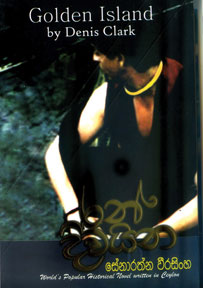Revisiting the Golden Island
Ran Divaina
Translator: Senaratne Weerasinghe
Prabha Publishers, Veyangoda
Reviewed by Padma Edirisinghe
Writers are a lucky lot, more so, the creative writers. A whole world
spreads around them for them to sieve out plots. Romance seems to be
going out of fashion. This is the post colonial period staged in the
aftermath of countries, both East and West, more East having rid
themselves of the boots of colonialism beginning to reflect on myriad
facets of the issue.
 But when Denis Clarke, an Englishman served in colonial Lanka in
1910—1920 when grandmas of those of our age were in their toddling
stage, there existed no colonial issue, then, taking for granted the
superiority of the Whites. We, the Blacks crawled underneath them except
for a chosen few. But Clarke’s strange novel is biased towards the
Sinhalese, although they were not black, but golden. Hence the name of
their island, the Golden Island. But when Denis Clarke, an Englishman served in colonial Lanka in
1910—1920 when grandmas of those of our age were in their toddling
stage, there existed no colonial issue, then, taking for granted the
superiority of the Whites. We, the Blacks crawled underneath them except
for a chosen few. But Clarke’s strange novel is biased towards the
Sinhalese, although they were not black, but golden. Hence the name of
their island, the Golden Island.
Who were the Blacks? The Tamils. Kalu in the translation.
The author is prejudiced against them and even their religion,
Hinduism. Steeped in their ritual, at times bloody, they dispelled the
placid notion of Nirvana.
The translator, Weerasinghe in his preface mentions the fact that the
original English one had been recommended a school library reader but
had been “ex—communicated” later in the 1940s. The reasons are obvious.
The writer has been very bold to put out this translation again after 12
years, when the first translation surfaced and at a time when the amity
between the two races is much needed.
Biased
However, the biased “Kona’s tale” or the content is the Sinhala prose
is presented mellifluently as the author is a seasoned translator having
put out a number of translations. The reviewer herself has gone through
many literary works by British writers of the colonial period on Ceylon,
some complimentary, some degrading.
Writing on colonial Ceylon began as early as the Portuguese period,
the outstanding writer being a Roman Catholic friar named Queroz who
amazingly was partial towards the colonised race. So, the matter of
partiality or bias lies in the mentality of the writer.
And if the translator had the boldness to stoke old issues that
better be forgotten that is all very well, as far as the independent
mental power of the translator is concerned. The background period
selected is the Glorious Period of Gamini, the mighty king who executed
the most successful onslaught on the Tamils. At a time when some are
brainwashed to spurn the memory of Dutta Gamini for the sake of national
amity the translator has shown a remarkable boldness, wise or otherwise.
The book finally true to the original ends up a Prasasthi or Ode to
king Gamini, encompassing even the building of Ruwanweliseya and his
final voyage to heaven, watched by those on earth! In this section the
original writer has no doubt been influenced by the Mahavamsa.
Quest
If a modern day child were to learn the strategies employed by the
two parties in their quest for power one could recommend this book. But
what is needed for today’s war-ridden world where thousands of innocent
lives including young lives are offered at the altar of belligerence are
not the education on war strategies and how to kill each other better.
The translator’s foreword, though not relevant to the book – theme is
very informative, especially on the change of attitudes of British
writers towards the colonies. Very condescending and critical at the
beginning, writers such as Woolf, the Bloomsbury writers and Eliot seem
to have changed the tide. Neruda is a Latin American writer whose
memoirs contribute towards this trend. It is new to learn that he has
visited Ceylon several times. Robert Knox’s book exposed the positive
side of Eastern life and again he plays a positive role being noble
enough to be magnanimous to his captors of 19 years.
However, one fails to see a connection between these facts and king
Gamini’s building of the Swarnamalee Chaitya with the help of Devas.
Other writers have the freedom to be irrational.
Anyway, good luck to this very busy “Translating machine” whose
translated works (minus a bias) seem to exceed 50. Again, to be Sri
Lankan sans a telling colour rather than a Kalu Damila or Fair Sinhalaya
(questionable again) augurs for the mental well-being of the nation.
|


